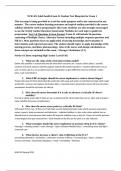NUR 425 Adult health Exam #1 Student Test Blueprint for Exam 1
This test map is being provided as a tool for study purposes and is not contractual in any
manner. The course student learning outcomes and topical outline provided in the course
syllabus should be used in preparing for this exam. Students are also strongly encouraged
to use the Weekly Guided Questions found under Modules for each topic to guide test
preparation. Test # of Questions & Item Format: Exam #1 will include 50 questions
consisting of Multiple Choice, Alternate Format including multiple-response questions and
Fill-in’s. Most questions focus on application of nursing knowledge and evaluation of
interventions and expected outcomes. The student should expect to apply knowledge of the
nursing process, nutrition, pharmacology, roles of the nurse, and dosage calculations as
these concepts are included in this exam. // Dosage Calculations (2-3)
Needs of Clients requiring High Acuity Care (8-10)
1. What are the steps of the crisis intervention model?
Define the problem = assessment and ask what their concerns are / ensure client safety / provide
comfort and assist client to identify support systems like family members / examine alternatives ex pt
was a runner, got in a car accident now has amputation so give different exercise methods / make
plans / get commitment
2. What EBP strategies should the nurse implement to reduce alarm fatigue?
Proper skin prep for ECG electrodes like wash skin with soap and water not alcohol and wipe with rough
washcloth / remove and replace electrodes daily / customize alarm parameters ex pts HR runs low then
parameters should be set lower for that pt
3. How does the nurse determine if it is safe to advance a critically ill client’s
mobility?
First do a safety screen like if vitals are ok, no abnormal HR, what meds they are on, alert and oriented /
early mobility decreases complications
4. How does the nurse assess pain in a critically ill client?
Self-report if they can / if they can’t talk then use the behavioral pain scale which assesses expression,
noises, speech, body movement and behaviors / sedation holiday is a doc order when patient has an
altered level of consciousness that makes RN stop the sedation once a day for 2 hours to let doc perform
a neurological and pain assessment / vitals should not be the use for pain as a sole indicator
5. What strategies should the nurse implement to promote sleep in ICU clients?
Massage / relaxing sounds / music therapy / open visitation flexible hours / controlling noise and light /
clustered care
6. What factors increase a client’s risk of delirium in the ICU?
preexisting dementia / alcoholism / admission severity of illness / increased age / sleep / anxiety /
sensory overload / electrolyte imbalance / meds / immobility / infection
NUR 425 Spring 2024
, 7. How does the nurse assess for the development of delirium and what
interventions can be implemented to prevent delirium.
Stop = do any meds need to be stopped or lowered? Sedative drugs need to be changed? / think = toxic
situation, hypoxemia, infection, immobilization, non-pharm interventions like glasses or hearing aids, K+
so electrolyte imbalances / medicate = no FDA approved drug, give Haldol possible but all pts getting
antipsychotics should be monitored for side effects like QT prolongation
8. What actions should the nurse implement to meet the nutritional needs of clients
in the ICU?
Nutritional state like daily weights, check labs like protein levels, prealbumin, electrolytes / enteral
feedings – tube placement use abdominal xray to confirm placement, 30-45 degree angle for bed to
prevent aspiration, check glucose levels every 6 hrs / if pts gastic volume is 250-500 higher than assess
for vomiting and pt might not be tolerating feeding so notify doc
9. How can the nurse effectively support family of clients in the ICU?
Warn family about how the room will look before family visits / update family of pts status / crisis
interventions so do a family assessment / family meetings
Care of clients with CAD, angina, and acute coronary syndrome (ACS), (18-20)
1. What are the risk factors for CAD?
Modifiable = smoking, obesity, diet, hyperlipidemia, hga1c / nonmodifiable = family history, age, race
2. What teaching should the nurse include in the client’s plan of care related to
reducing risk factors for CAD?
Teach patients what they can control like their diet, 150 min a week physical activity, quit smoking, and
manage HTN and diabetes
3. Compare and contrast the different types of angina and differences among
clinical manifestations and treatment approaches, including medications.
Stable angina = rest or nitroglycerin resolves chest pain / unstable angina = chest pain does not go away
with rest or nitroglycerin, trop will not be elevated, EKG, Medications – Morphine, Oxygen,
Nitroglycerin, Antiplatelets (ex: aspirin, clopidogrel), Beta-Blockers (ex: metoprolol), Calcium Channel
Blockers (ex: amlodipine, diltiazem), Anticoagulants (ex: heparin) / prinzmetals = chest pain at rest, ST
elevation goes away when treated with CCB (amlodipine and diltiazem) / silent ischemia = neuropathy in
body and has evidence of ischemia with no pain ex older adults or diabetic pt so do a stress test on
these pts / treatment = EKG within 10 mins, administer oxygen, administer nitro, prepare for cath lab or
thrombolytic therapy / intractable or refractory = chest discomfort from a heart transplant
4. What are the clinical manifestations, diagnostic findings, and treatment
approaches, including medications for ACS (USA, NSTEMI and STEMI)?
Increased HR and BP, vasoconstriction, cardiac output will fall, NV, indigestion, possible HR with crackles
in the lungs or heart murmur / get an EKG within 10 mins, cardiac cath, labs troponin
-USA = acute chest pain that does not go away, dyspnea, palpitations, syncope / stop activities
NUR 425 Spring 2024




